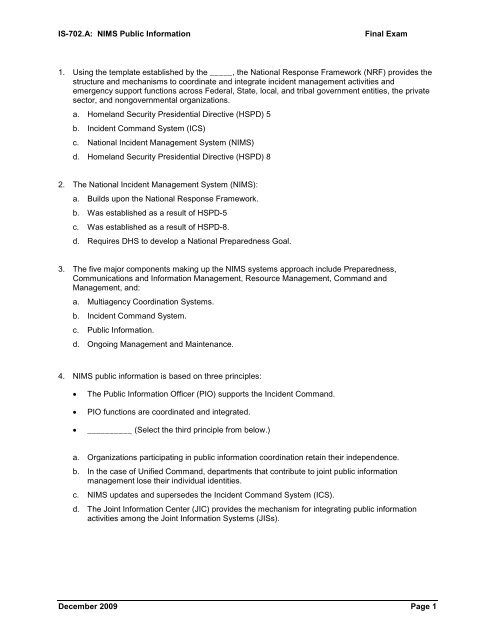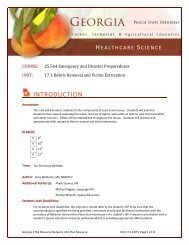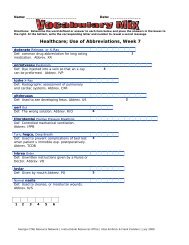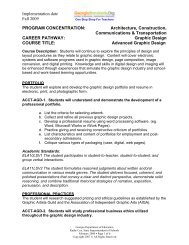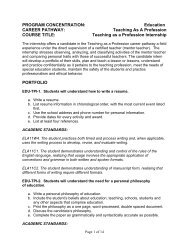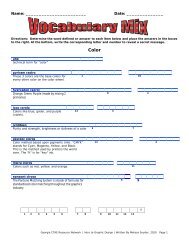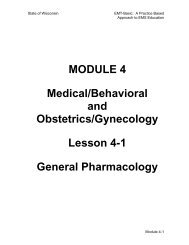IS-702.A: NIMS Public Information Final Exam December 2009 Page ...
IS-702.A: NIMS Public Information Final Exam December 2009 Page ...
IS-702.A: NIMS Public Information Final Exam December 2009 Page ...
Create successful ePaper yourself
Turn your PDF publications into a flip-book with our unique Google optimized e-Paper software.
<strong>IS</strong>-<strong>702.A</strong>: <strong>NIMS</strong> <strong>Public</strong> <strong>Information</strong><strong>Final</strong> <strong>Exam</strong>10. Which of the following statements is FALSE?a. The J<strong>IS</strong> can be as simple as two PIOs talking on the phone about an incident that involves bothof their agencies.b. PIOs must be co-located and working to meet public information needs from a central locationonce the J<strong>IS</strong> is activated.c. The J<strong>IS</strong> can be PIOs from many agencies working from several locations to ensure delivery ofclear, accurate information.d. The J<strong>IS</strong> must involve PIOs working together in responding to an incident to ensure that the rightmessage is delivered to the right people.11. Through the J<strong>IS</strong>, PIOs are able to create coordinated and consistent messages by collaborating to:a. Communicate to the public all information that is available about an incident.b. Withhold alarming information from the public to eliminate possible hysteria and panic.c. Disseminate information as soon as it is received while simultaneously verifying the information’saccuracy.d. Prioritize messages to ensure timely delivery of information without overwhelming the audience.12. Which of the following statements is FALSE?a. Working together in the J<strong>IS</strong> helps PIOs focus on releasing one or two coordinated, keymessages.b. Designating spokesperson(s) for media interviews helps PIOs in the J<strong>IS</strong> avoid releasingconflicting messages.c. Activation of the J<strong>IS</strong> eliminates the desirability of using pre-scripted messages and talking points.d. PIOs working in the J<strong>IS</strong> might only speak publicly about their own agencies, programs, and/orareas of responsibility.13. Which of the following statements is FALSE?a. Print media want lots of information, details, and background.b. Television works in the "here and now" and wants visuals and short sound bites.c. Radio typically is better than television at conveying complex or very detailed information.d. Electronic media typically get information out to the public more quickly than print media.<strong>December</strong> <strong>2009</strong> <strong>Page</strong> 3
<strong>IS</strong>-<strong>702.A</strong>: <strong>NIMS</strong> <strong>Public</strong> <strong>Information</strong><strong>Final</strong> <strong>Exam</strong>14. Which of the following statements is FALSE?a. Authority to tap other departments or agencies for staff during an incident may be written into lawand tied to an emergency declaration.b. Mutual aid and assistance arrangements and Memorandums of Understanding (MOUs) cannotbe used for supplementing incident staff.c. Hiring policies should be written ahead of time to allow for emergency hiring authority for part- orfull-time temporary positions.d. One way to supplement regular PIO staff during an incident is to use disaster employees or “oncall”staff with public information expertise.15. When planning for responding to an incident, consider facilities, equipment, and supplies necessaryto meet public information needs:a. During incidents when operating alone as sole PIO and those when operating with a small orlarge group of PIOs at a fixed location.b. During incidents when your agency or department would be providing the leadership in theIncident Command.c. During incidents that are likely to involve only your own agency or department.d. During only the predictable and expected types of incidents that are common in your area.16. For a PIO to be ready to respond to a variety of incidents, he or she should assemble a _______containing such items as a cell phone, digital camera, pager, and contact information for disasteremployees and the news media.a. Smart Bookb. Toolboxc. Emergency systemd. Go kit17. Which of the following statements is FALSE?a. Pre-incident activities include planning to prepare and establish a JIC by establishing a dedicatedlocation where PIOs can work.b. Pre-incident activities include planning to prepare and establish a JIC in every incident requiringemergency response.c. Pre-incident activities include planning to prepare and establish a JIC by identifying necessaryequipment and supplies.d. Pre-incident activities include planning to prepare and establish a JIC by practicing “morphing”the space into a JIC.<strong>December</strong> <strong>2009</strong> <strong>Page</strong> 4
<strong>IS</strong>-<strong>702.A</strong>: <strong>NIMS</strong> <strong>Public</strong> <strong>Information</strong><strong>Final</strong> <strong>Exam</strong>18. An effective Emergency Operations Plan will be:a. General in nature, so respondents’ roles can be determined on scene as the incident dictates.b. Specific to the types of incidents that have occurred in that jurisdiction in the past.c. Based on all risks facing any region in the Nation, in order to comprehensively address everypossibility.d. Comprehensive in nature, including complete response procedures for everyone with a role in theresponse.19. Contents of the ________ might include such things as the public information mission, organization,specific functions, and concept of operations.a. <strong>Public</strong> Inquiry Centerb. Memorandum of Understandingc. <strong>Public</strong> <strong>Information</strong> Annexd. Emergency Alert System20. The J<strong>IS</strong> is _____; the JIC is _____.a. A way of operating; the location where the operation takes placeb. A plan for operating; the implementation of the operational planc. Activated when size or complexity dictate; activated in every type of incidentd. A network of scattered PIOs at an incident; a centralized location for all of an incident’s PIOs21. Establishing a JIC as part of incident response offers the following benefits:• A central working facility• Pooled resources• Strength in numbers• Safety• _____ (Select another benefit from below.)a. Recognized source of information.b. Fewer PIOs needed.c. Opportunity to release multiple detailed messages simultaneously.d. Reduced need to coordinate messages.<strong>December</strong> <strong>2009</strong> <strong>Page</strong> 5
<strong>IS</strong>-<strong>702.A</strong>: <strong>NIMS</strong> <strong>Public</strong> <strong>Information</strong><strong>Final</strong> <strong>Exam</strong>22. Getting information to the public during an incident is an ongoing cycle involving four steps. Whichsequence below shows the correct order of these steps in accomplishing the public informationmission?a. Gathering, Verifying, Disseminating, and Coordinating <strong>Information</strong>.b. Gathering, Verifying, Coordinating, and Disseminating <strong>Information</strong>.c. Coordinating, Gathering, Disseminating, and Verifying <strong>Information</strong>.d. Coordinating, Gathering, Verifying, and Disseminating <strong>Information</strong>.23. Establishing key message(s) by prioritizing information to get out to the public is one example of:a. Gathering information.b. Verifying information.c. Coordinating information.d. Disseminating information.24. In assessing readiness after an incident is over, and deciding what you want to do differently nexttime, set goals regarding:a. Output, documentation, systems issues, and facilities maintenance.b. Output, systems issues, logistical factors, and human factors.c. Logistical factors, human factors, documentation, and risk analysis.d. Risk analysis, facilities maintenance, documentation, and systems issues .25. The following strategies are examples of ways to improve _____.• Identify equipment that could help you be more effective.• Research new technology that will improve operations.• Research costs and other factors for consideration during the appropriate budget cycle.a. Outputb. Systemsc. Logistical factorsd. Human factors<strong>December</strong> <strong>2009</strong> <strong>Page</strong> 6


